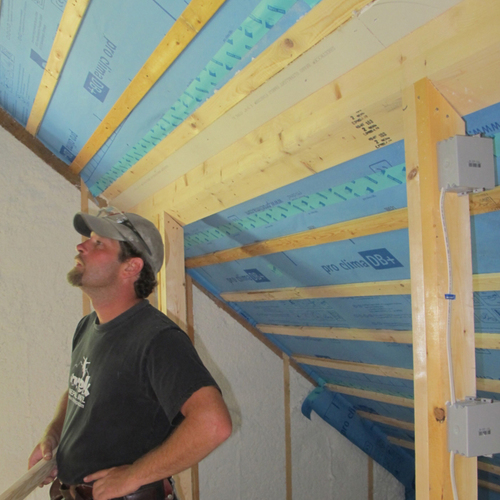
Image Credit: Sustainable Performance Institute
Dr. Joseph Lstiburek needs little introduction. The well-known Canadian engineer is a principal of the Building Science Corporation in Massachusetts. He’s also a regular GBA podcaster and Fine Homebuilding author.
On Wednesday, June 6th, I attended an all-day building science class presented by Dr. Joe in Westford, Massachusetts. As usual, his presentation combined salty language, corny jokes, light-hearted insults, and rock-solid building science information.
Although I’ve been listening to Joe’s presentations for at least 13 years, I learn something new each time I hear him speak. This time around, I harvested two news stories, one six-digit idea, and at least 16 interesting quotes.
News story #1: Don’t trust published perm ratings for vapor-retarder paint
Every now and then, someone posts a question about vapor retarders on GBA’s Q&A page. Over the years, I’ve often recommended the use vapor-retarder paint on interior drywall. Vapor-retarder paint is less problematic than interior polyethylene; moreover, the paint should satisfy a building inspector looking for a code-required 1-perm vapor retarder on a home’s warm-in-winter surfaces.
I have also recommended the use of vapor-retarder paint on cured open-cell spray foam installed against the underside of roof sheathing in cold climates. This method of vapor control was suggested to me several years ago by Joe Lstiburek, who told me that some type of vapor retarder is necessary in cold climates to prevent moisture accumulation in the sheathing.
Here’s the news: after delving into the nitty-gritty details of vapor-permeance testing of vapor-retarder paints, Lstiburek has concluded that the vapor permeance rating listed in the manufacturers’ specs (usually 1 perm) only occurs in a lab, not in the real world.
The 1-perm value is an artifact of the laboratory testing method usually used by paint manufacturers — a type of test that doesn’t…
Weekly Newsletter
Get building science and energy efficiency advice, plus special offers, in your inbox.

This article is only available to GBA Prime Members
Sign up for a free trial and get instant access to this article as well as GBA’s complete library of premium articles and construction details.
Start Free TrialAlready a member? Log in















44 Comments
How about house wrap with bumps?
Don't have any experience with this stuff, and I am not sure if the bumps are big enough to create a large enough gap to actually function as a rain screen, but this stuff from Obdyke looks like an interesting option: http://www.benjaminobdyke.com/visitor/product/key/hydrogap
Response to Carl Seville
Carl,
There are lots of brands of bumpy (or crinkled) housewraps out there, and they work.
The one that Joe Lstiburek usually uses is Tyvek DrainWrap.
A softening position?
“I have a problem with the Passivhaus people, because they are building ugly freaking boxes. The only way to get a building to last a long time is if the building is maintained, and people have to want to take care of it. People do not take care of ugly things.”
Well... I guess his complaints about Passivhaus people are no longer that we employ:
-Excessive insulation.
-Excessive airtightness.
-Excessive personalities. Well, perhaps he's still right on that one :).
His holdout position is down to: --that we have no taste--
I can live with that because I know that his expertise is in engineering, not design :)
New (to Me) Video
I was looking at the related articles mentioned above.
I was not aware of the "Roofs Video, Part 2" until today
https://www.greenbuildingadvisor.com/roofs-video-part-2-ice-dams-lstiburek
Very Nice
Thanks for the recap...
I’ve follow BSC detailing on basement insulation for many years with good results for CZ2-5. The worry I always have is how long to let the wall dry as much as possible before we finish it, as concrete can take a long time to dry.
BSC wrote a few good papers back in 2002 and 2006 about basement walls and insulation, but I wish they update them if Joe has change his mind about some of those issues. “I made a mistake. The insulation just needs to be warm enough to control condensation from the inside. The perm rating doesn’t matter. It’s OK for the concrete to be wet. The concrete doesn’t have to dry to the inside.” Really puts a twist on few designs I’m doing now.
Thanks for showing some Joe'isms, they are always fun to read/hear.
There is only one Joe L.
There is only one Joe L. Great, fun, quotes. But tell Joe I have two homes doing perfectly fine and moisture free with open cell spray foam done how he now says won't work.
I do see he agrees with my spray foam guy that overinsulating is a waste as little is to be saved after the first few inches if done well. Good sighting, good windows and design.... for me has resulted in PGHs (pretty good homes). And have to mention Panasonic bath fans. Panasonic fans have turned out to be singularly good, great, choice to include in homes for too many simple reasons. They do a good job dependably and quietly. And require no maintenance, sensors or warning lights, or maintenance contracts, or changes in real estate sales laws. A six digit idea that already exists.
One more smile. Glad to see Joe likes OSB as much as I do. Choose plywood people. The cost difference is tiny compared to the project cost.
Plywood, Panasonic and Joe L, all the best parts of a PGH.
Martin - Wrinkled house wraps - do they really work?
I read this in a post about wrinkled house wrap by some nerdy guy who seems pretty smart:
"In order to evaluate these products, one question arises: How thick does a corrugation need to be in order for water to drain? Unfortunately, building experts disagree on this issue, which awaits further research. “An air gap does not have be 3/4 inch,” says Mark Bomberg, editor of Journal of Thermal Envelope and Building Science. “I am quite happy with an air gap that is less than 1/8 inch. It does not ventilate, but it allows local drainage.”
This seems to contradict the idea about that bumps would provide ventilation and drainage. Seems to me that bumps on OSB or siding wouldn't be any bigger than the wrinkled or bumpy wraps.
Has there been further research that I missed a report on?
https://www.greenbuildingadvisor.com/blogs/dept/musings/all-about-water-resistive-barriers
Response to Carl Seville
Carl,
You're right that crinkly housewraps don't provide very much ventilation drying -- although, believe it or not, they may provide some useful ventilation drying. These crinkly housewraps can definitely provide what Joe Lstiburek calls "hygric redistribution." In some applications -- notably when used between exterior rigid foam and OSB sheathing -- this hygric redistribution can be extremely useful.
Here's why Joe wrote in his article Mind the Gap:
"Yes, closed cell high-density foam cavity insulation applied to the inside of OSB sheathings that are in turn covered on the exterior with impermeable foam sheathings is risky. Unless you provide a small gap between the exterior face of the OSB and the back surface of the foam sheathing to provide for some hygric redistribution. Or if you are “perfect” with your rainwater control such as when you use a fully adhered membrane – think roof membrane standing up applied to a wall. Otherwise, go with a gap. What works? Grooved foam, “bumpy” OSB, “crinkled” building wrap, 1/8-inch polypropylene mesh, dimpled polypropylene sheets. "
If you want to design an air gap between your siding and sheathing to help dry a wall through the ventilation effect, deeper gaps work better than narrow gaps. It's also beneficial to have openings at the bottom and top of the wall. The bigger the gap (up to a reasonable depth, usually maxing out at about 3/4 inch), the better the ventilation effect.
However, not all walls need ventilation drying to stay out of trouble.
In one of his papers, John Straube discusses the findings of a 2001 research study. The study found:
"Walls with cavities (vented and ventilated) dried faster than comparable panels without cavities (face-sealed). There was a substantial range in the drying rates: as much as three times higher drying rate for comparable walls with a ventilated cavity than for those without.
"Ventilation (top and bottom vents) resulted in marginally faster drying than vented (bottom vents) walls. The width of cavity was also important, and those walls with cavities of 19 mm dried faster than 10 mm.
"Walls with plywood dried faster than comparable walls with OSB sheathing. OSB has a lower vapour permeance than plywood and may have restricted the drying through the sheathing to the exterior."
However, further research has shown that even very small gaps are quite useful. In The Role of Small Gaps Behind Wall Claddings on
Drainage and Drying, John Straube wrote,
"The experiments to date have conclusively shown that even small gaps (less than 1 mm) can drain more water than would normally be found in a drainage gap. It was also found that in some cases small gaps will store less water than a large drainage gap. It was also found that ventilation drying can play a role in very small gaps of approximately 1 mm, at a pressure difference of only 1 Pa. More research is required to further analyze optimal ventilation gap sizes and compare the laboratory results to hygrothermal modeling."
Basement wall
If the basement wall doesn't dry to the inside, where does it dry to? Or is it just always permeated with moisture?
Response to Shane Claflin
Shane,
For strong concrete, you want to make the mix as dry as possible before it is placed, with a minimum amount of water -- just barely enough water to allow the concrete to be placed.
Once the concrete has been placed and has begun to cure, you want to keep the cured concrete as damp as possible. The concrete will continue to strengthen for months, even years, as long as you keep it damp.
In other words, damp concrete is happy concrete -- and strong concrete.
However, you don't want a damp basement, and you don't want damp concrete to be drying to the interior or adding moisture to your home. That's why a layer of closed-cell spray polyurethane foam or rigid concrete between the concrete wall and the interior is such a good idea. It prevents evaporation.
Agree, but...
I understand and agree with your statements Martin, however, there is the issue that we'll trap moisture in the concrete wall between the asphalt waterproofing and the close cell foam...If that is good for the concrete, at what point should we install the rigid foam, right after we waterproof the outside or wait till we finish a basement?
Now I’m designing a lake house, east of Dallas, with a walkout basement where all the social areas (kitchen, living, dining, and office) are located, and we’ll be finishing the basement as we finish the house; so my concern is trapping too much moisture on the foundation wall too quickly. I’m specifying 2” of rigid foam against the concrete, flat 2x4 wall with no insulation, and sheetrock. Would that create problems?
Response to Armando Cobo
Armando,
I'm happy to defer to other opinions here, but my guess is that, as long as a portion of the basement wall extends above grade on the exterior, as it should, the exterior air and sunshine will ensure that the wall eventually dries out enough for you not to have to worry about it.
Here's another reason you shouldn't worry: ICF basement walls seem to perform well, and they have foam on both sides.
Thanks
Good thinking on the ICF, I've done a few, and never worried about that before.
Venting rigid
Leaving a drainage/vent plane behind the exterior rigid seems counterintuitive to me - why isn't that short-circuiting the rigid as insulation?
Venting Rigid
Dan,
Joe addresses this on page 7 of "Mind the Gap, Eh"
http://www.buildingscience.com/documents/insights/bsi-038-mind-the-gap-eh/files/BSI-038_Complex_Mind_the_Gap.pdf
Right
Here's the quote:
"What works? Grooved foam, “bumpy” OSB, “crinkled” building wrap, 1/8-inch polypropylene mesh, dimpled polypropylene sheets. Lots of stuff. But won’t the tiny gap cause a loss of thermal performance of the foam sheathing? Yes. How much? About 5 percent of the thermal performance of the foam sheathing (not the entire wall assembly) with the 1/8-inch gap, less with a smaller gap. With “crinkly” stuff you loose next to nothing.7 Is it worth it? Yes, in my opinion, the loss in thermal performance is trivial compared to the reduced risk and improved durability."
He's talking about pretty tiny gaps. I would guess the thermal loss increases more than linearly as the space increases but of course am speaking out of my ass.
Response to Dan Kolbert
Dan,
You're right: if you're choosing a product to provide a gap between OSB and rigid foam, you want to choose a product with a tiny gap, so that the gap doesn't lower the thermal performance of your wall very much.
The large ventilated rainscreen gaps -- especially those achieved with vertical furring strips -- always go between the siding and the sheathing, not the rigid foam and the OSB.
Using spay foam on basement exterior
Is it acceptable practice to use closed cell spray foam on the exterior of a concrete basement below grade, and then backfill against it?
windows with suspended films
I'd like to know more about why Joe "hates" this technology. What, specifically, does he believe doesn't work about them? I live in the cold north and have used triple glazed windows for more than a decade, but have recently specified windows with suspended films on a few projects.
ICF analogy
Martin, I'm not sure about the statement "ICF basement walls seem to perform well, and they have foam on both sides." But that's with (semi-permeable) EPS. In my plan reviews I've stated concern with proposed assemblies that include, for example, a few inches of XPS on the outside of a basement wall, and high-density spray foam to fill the furred-out cavity on the inside. Joe would call this a "vapor barrier sandwich"... isn't he only saying that, if the outside is vapor open, it's then OK to have a vapor barrier on the inside? He hasn't said (that I know of) that it would not cause problems to have a vapor barrier on both sides of a basement wall.
Response to Ron Keagle
Ron,
Q. "Is it acceptable practice to use closed cell spray foam on the exterior of a concrete basement below grade, and then backfill against it?"
A. Yes. Researchers have found that spray foam performs well in this application. For more information, see these documents:
In situ performance evaluation of spray polyurethane foam in the exterior insulation basement system.
Spray Polyurethane Foam for Exterior Subgrade Thermal and Moisture Protection.
Response to Rachel Wagner
Q. "I'd like to know more about why Joe 'hates' this technology [windows with suspended films]."
A. I'll send Joe an e-mail today and ask him to comment on your question. I know that some of the Heat Mirror units from the 1980s had problems with transparency and film durability.
Response to Katy Hollbacher
Katy,
You're right that the EPS foam used for ICFs is somewhat more permeable than XPS, but once you increase the thickness of the EPS to 4 inches, the permeance is below 1 perm -- so you aren't getting much drying through your foam.
You wrote, "In my plan reviews I've stated concern with proposed assemblies that include, for example, a few inches of XPS on the outside of a basement wall, and high-density spray foam to fill the furred-out cavity on the inside." But what is your concern? It's one thing to be concerned when OSB is sandwiched between impermeable layers, because OSB is a wood-fiber product that is susceptible to rot. But concrete doesn't rot. In fact, it likes to be damp.
I will send Joe an e-mail and ask him whether he is concerned about the creation of a "vapor barrier sandwich" with concrete in the middle of two layers of foam. But here's my answer: I'm not concerned.
Response to Katy Hollbacher
Katy,
When I say I made a mistake about basements, the context is important. The assemblies I recommended back then all work. Even today.
The mistake was that I thought that some drying of the concrete was necessary or important. I do not believe that any longer. That is what i consider my "mistake." Additionally, we have found that most foundation walls dry upwards and outwards at grade in any event.
So to answer your question directly, I do not believe there is a problem if there is a vapor barrier on both sides of a concrete wall and the concrete never dries. The concrete is perfectly happy. The key is to make sure that the interior surfaces of the foundation are protected from the wet concrete and that interior air can not access cold surfaces.
Response to Rachel Wagner
Rachel,
I have only had bad experience with windows with suspended films as they experience creep and the tensioning methods are not able to compensate. The creep phenomenon is not uniform and leads to the films becoming visible overtime and unsightly. There is no apparent effect on thermal performance, only aesthetics.
Concrete, ICFs & suspended films
Joe & Martin,
Thank you for clarifying--this is very helpful & I'm pleased with the revised view on this. I do still feel a bit uneasy about the idea of trapping water very deep below grade; if the wall is fully insulated on both sides all the way up to the sill, and there's a capillary break between the top of wall & mudsill, the wall won't be able to dry out above grade either, right? But your point is, who cares. Hmm... could concrete efflorescence degrade insulation over time? I suppose that's a question for any situation.
On the other topic of window suspended films: Joe, can you share more about your observations: are these newer or older products? large, average or small openings? squarish or rectangular? I've heard about issues with very large (say 5x6 or larger) openings, or those with very different aspect ratios, showing distortion at corners--but haven't heard of this with average opening sizes made with current generation products.
Response to Katy Hollbacher
Katy,
Q. "Could concrete efflorescence degrade insulation over time?"
A. Efflorescence requires several conditions: the concrete has to be taking up water with dissolved minerals; this often occurs when the water rises through a footing that lacks a capillary break. So one way to interrupt or limit efflorescence is to include a capillary break between the footing and the wall.
Another requirement for efflorescence: the concrete wall has to be exposed to an environment that is dry enough to permit evaporation of the moisture from the concrete. This doesn't happen when the concrete is covered with rigid foam. So you aren't going to have "hidden" efflorescence magically occurring under the foam. Water will not be evaporating from the concrete, so the buildup of minerals won't occur.
Great comments, concerns and questions.
Valueable insights by all. Thanks Dr Joe, Martin, and (mama?) Katy.
Hmmm... "Martin, Dr Joe and Mama Katy"... Kinda sounds like the name of a 60's rock band...
Latex Paint - Code - Air gap
Thanks for the great article. Especially is dry climates I have never understood the rational in the code to only allow latex paint as a class 3 vapor barrier if there is a gap between the siding and the drainage plane. The code language give examples of this gap but does not go far enough on the rational behind it to allow code officials to feel comfortable allowing other assemblies to utilize a latex paint VB. Plastic in our walls seems like a bad idea in almost every climate because it is installed so badly and has such a potential to trap moisture in the wall that is carried in via air leakage. I believe Joe got this language into the IECC so I was wondering if he commented on it more that to say that paint works as a VB when installed on drywall.
Thanks
Response to Robby Schwarz
Robby,
Joe Lstiburek didn't address your questions in his recent all-day seminar. However, I'll do my best to answer them.
Q. "Especially is dry climates, I have never understood the rationale in the code to only allow latex paint as a class 3 vapor barrier if there is a gap between the siding and the drainage plane."
A. The need for interior vapor diffusion retarders has been greatly exaggerated for decades. Vapor barrier requirements crept into our building codes based on a misunderstanding rather than science or research.
Wet-wall problems are almost never caused by outward diffusion during the wintertime. The most common cause of wet-wall problems is wind-driven rain that gets past windows or flashing. The second most common cause is condensed moisture that entered the wall cavity with exfiltrating air.
The code changes you are referring to (the provisions shown in Table N1102.5.1) were an attempt to reduce the stringency of illogical requirements. These changes were introduced by building scientists (including Lstiburek) who knew that interior poly was doing more harm than good in many climates. The table indicates the types of walls that are so safe that interior poly is, by universal agreement, unnecessary. These walls include those with adequate insulated sheathing (usually rigid foam, although mineral wool would also work) and certain walls with a ventilated air gap between the siding and the sheathing.
Q. "The code language give examples of this gap but does not go far enough on the rationale behind it to allow code officials to feel comfortable allowing other assemblies to utilize a latex paint VB."
A. You're right. But then again, the code has never been very good at providing rationales or explaining who certain provisions exist.
Q. "Plastic in our walls seems like a bad idea in almost every climate because it is installed so badly and has such a potential to trap moisture in the wall that is carried in via air leakage."
A. I agree.
Builders Guides
Martin,
If only there WERE Builders Guides for every climate zone! Those of us living in the Marine Climate long for the day Joe and Building Science Corp produce a guide for our climate. In the interim, we make due with the Building America Marine Climate Best Practice Guide available at http://www1.eere.energy.gov/buildings/building_america/marine_case_studies.html. This guide was produced by Building Science Corp for US Dept of Energy, but the section on building is not nearly as large as what you'll find in the Builders Guides. We really do need a full guide for the Marine Climate!
Bill
Response to Bill Burke
Bill,
You make a good point.
So Joe -- if you're reading this -- you've got at least one eager customer ready to buy the next edition of your book, as soon as it's written ....
Houses Without Basements
For houses, how popular is the idea of simply eliminating basements and all direct ground contact (including slab foundations) in order to eliminate the affect of moisture and mold?
Basement-less houses still need foundations, but foundations could be provided as piers. If you need the space provided by a basement, you can just make the aboveground house larger.
With super tight, superinsulated houses, the basement can really drag down the quality of the house space.
Response to Ron Keagle
Ron.
Most builders who are frustrated by the disadvantages of basements and crawl spaces are happy with slabs on grade.
Pier foundations work in warm climates, but they are more difficult in cold climates, where plumbing pipes and drain pipes can freeze.
very good
Very good info here, and I am glad to see that Dr Joe, etc, can admit to being human and accepting a change of opinion as BS evolves. One comment is disappointing, though. To hear a person who is well respected in the BS community say that PH is building ugly boxes is at best unfortunate, and at worst ammunition for the crowd who does not buy into the concepts of conserving energy. Beauty is in the eye of the beholder, and there is nothing, IMO, but visceral excitation in seeing low energy bills. I'd suggest nothing negative be said about those who chose function over form; an age-old battle.
Choose function and form. As
Choose function and form. As to Joe, if you go to his seminars, every word is worth the price of admission. And you will also find out he has opinions and is great at expressing them! Much more good than harm ... ya just gotta know, Joe.
More on windows with suspended films
Joe Lstiburek has been responding to several e-mailed questions on insulated glazing units with suspended plastic films, and pointed out that he installed 18 such windows and "all have gone bad." While it's true that many of these windows are performing well, even after 17 years or more, some (like Joe) have had less satisfactory experiences.
Joe wrote, “I am done with films. I am replacing everything with triple-glazed units. Tired of being someone’s guinea pig. In this case -- been there, got burned, got the T-shirt, and have moved on. I looked at the engineering solution to the physics problem and have said no.”
AJ: Small
AJ: First, this is NOT a large issue, but I think worth mentioning to keep "the team spirit" intact. Joe is knowledgeable, etc, etc, but he ain't perfect and he does not levitate. A little tact can go a long way. Too, IMO, a good minister is very careful when preaching to the choir because the words go beyond the choir. That's my point; other folks, esp PH folks, may take offense. It's just a small thing, but something to be aware of. I've shot myself in the foot being "humorous" more than once.
John, Joe deals with the
John, Joe deals with the likes of me and builders and tradesmen, etc and his preaching is perfect for us roughians. You want Jesus, go to church my man.
Oh, and am sure Joe levitates, deviates, hesitates, necessitates, eradicates, delineates, desiccates, and especially pontificates ..
Mike Eliason responds to Joe Lstiburek
Evidently Mike Eliason didn't agree with Joe's observation that "the Passivhaus people ... are building ugly freaking boxes." So he wrote a blog in response: Dr. Joe should stick to building science."
Response to Joe Lstiburek
Great guy. I followed the advice on BSC's website and wasted several months of work and $6,000.
Perhaps our installers mess up and it's not BSC's fault but it seems that the BSC docs are too theoretical and make assumptions about the environment that simply don't apply in reality.
Don, your last post is
Don, your last post is premature IMO. You should ask them to inspect your home. Both of you and us would learn from getting your home properly functioning. At this point they should if you all could agree to stay out of court help you pro bono IMO.
Insulating limestone "rubble" foundation walls
Most of the closed-cell foam insulation conversation above refers to concrete foundation walls. I'm wondering about how this information applies to retrofitting insulation into historic home basements with limestone rubble foundation walls that do not have any exterior waterproof coatings.
These basements almost always have moisture migrating in through the wall (sometimes in bulk water form, other times in vapor form). Historic mortars behave in a substantially different manner than concrete, though clearly a masonry wall could dry up and out rather than in to the basement just like a concrete wall could.
I'd be interested in anyone's thoughts specific to this situation.
Response to Steve Wilke-Shapiro
Steve,
The details of your insulation retrofit will depend on how wet your basement gets. Here is a link to the oft-cited report by Joe Lstiburek on his own rubble-foundation interior insulation retrofit: Rubble Foundations.
If you anticipate a lot of water coming through the wall, it makes sense to include a three-dimensional drainage mat product plus geo-textile fabric between the stone and the spray foam. However, many such foundations are insulated by spraying the insulation direction on the stone. After all, there are enough cracks and crevices in such walls for any liquid water to find its way to the footing. It's usually a good idea to have an interior French drain (connected to a sump) to handle any water that gets through the wall.
Closed-cell spray foam is tenacious, and helps bind loose stones to the wall. You end up with a stronger foundation.
Log in or become a member to post a comment.
Sign up Log in